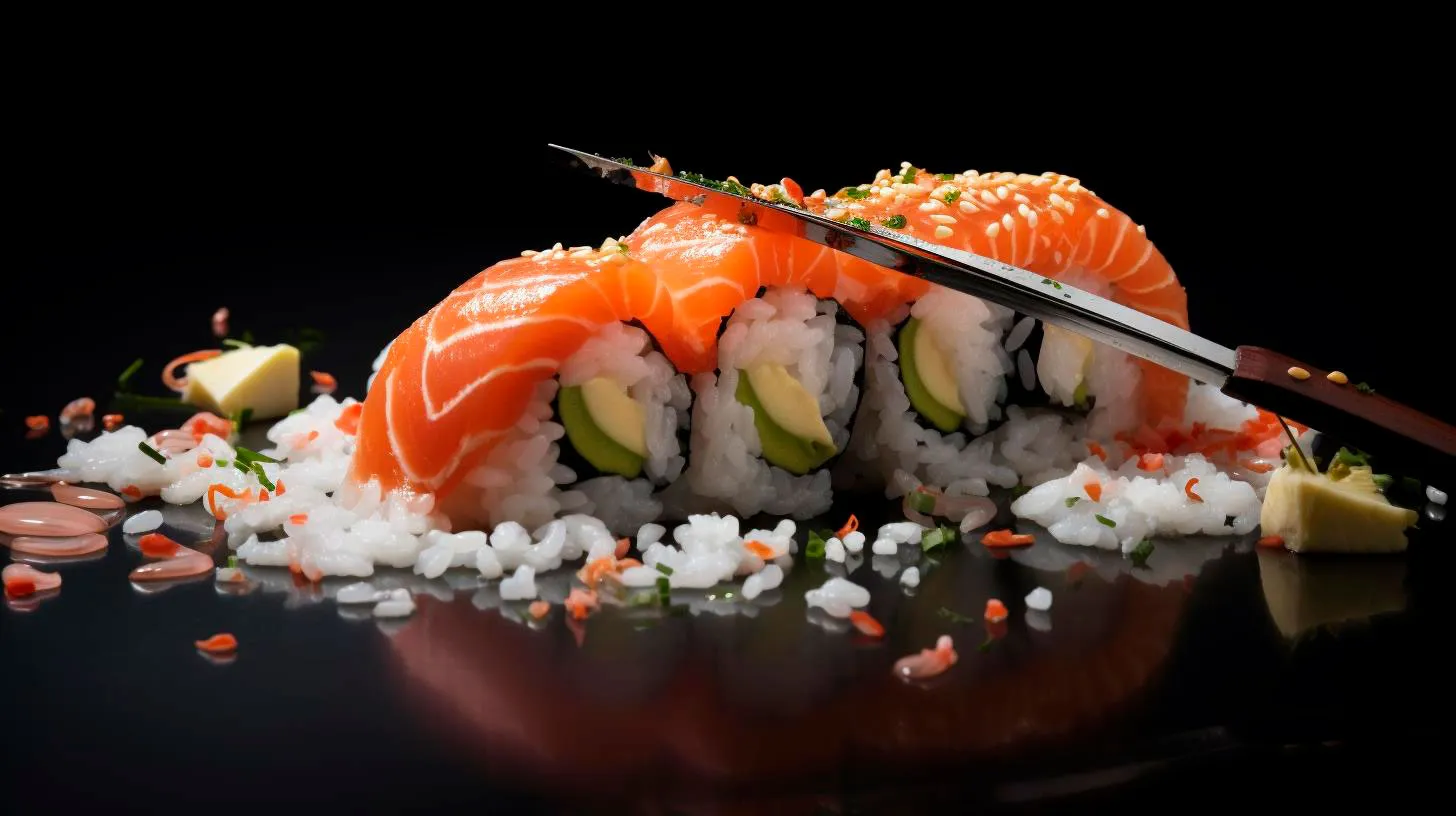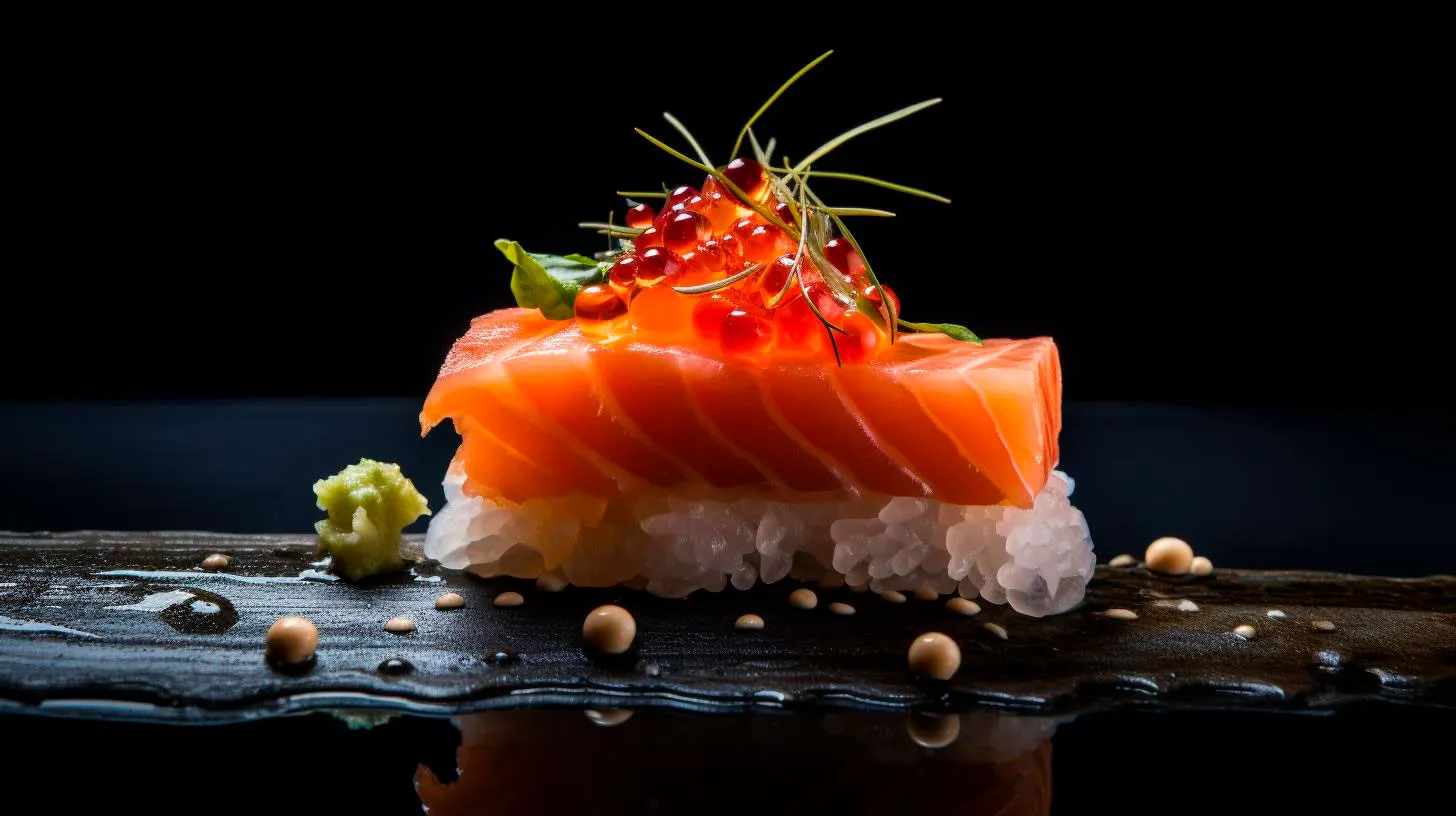Cauliflower Rice Rolls: Low-Carb Sushi Made Easy
So, let’s dive in and discover how to make this delectable treat!
The Rise of Cauliflower Rice
In recent years, cauliflower has gained immense popularity as a versatile ingredient that can replace high-carb grains and starches. From pizza crusts to mashed “potatoes,” cauliflower has become a staple for those seeking healthy eating options. One of its most exciting uses is in creating a low-carb alternative to traditional sushi rice.
The Benefits of Cauliflower Rice Rolls
Switching to cauliflower rice rolls provides numerous benefits for your health and well-being. Let’s take a closer look at some of the advantages:
- Low in Carbohydrates: Traditional sushi rolls are loaded with carbohydrates due to the rice used. Cauliflower rice, on the other hand, is significantly lower in carbs, making it ideal for individuals following a low-carb or ketogenic diet.
- Packed with Nutrients: Cauliflower is rich in vitamins, minerals, and antioxidants. It’s an excellent source of vitamin C, vitamin K, and folate. By incorporating cauliflower into your sushi rolls, you’ll enjoy a nutritious boost with every bite.
- Weight Management: As cauliflower rice rolls are lower in calories and carbohydrates compared to traditional rolls, they can support weight loss efforts and help you maintain a healthy weight.
- Vegan and Gluten-Free: For those following a vegan or gluten-free lifestyle, cauliflower rice rolls offer a fantastic alternative to conventional sushi, which often contains animal products or gluten-based ingredients.
- Great Taste and Texture: With the right seasoning and preparation, cauliflower rice rolls closely mimic the taste and texture of traditional sushi rice. You won’t miss a thing!
How to Make Cauliflower Rice Rolls
Now that we’ve discussed the benefits, let’s move on to the exciting part: making cauliflower rice rolls at home! Follow these simple steps:
- Prepare the Cauliflower Rice: Start by cutting a cauliflower head into florets. Next, pulse the florets in a food processor until they resemble fine rice grains. Steam or microwave the cauliflower rice for a few minutes until slightly tender.
- Season the Cauliflower Rice: Transfer the steamed cauliflower rice to a clean kitchen towel or cheesecloth. Squeeze out any excess moisture to achieve a drier texture. Place the cauliflower rice in a bowl and season it with a touch of rice vinegar, salt, and a pinch of sweetener (optional).
- Prepare the Fillings: Select your desired fillings, such as fresh vegetables, avocado, or cooked protein like tofu or shrimp. Slice them into thin strips or julienne for easy rolling.
- Roll It Up: Lay a sheet of nori (seaweed) on a bamboo sushi mat. Spread a thin layer of cauliflower rice evenly over the nori, leaving a small border at the top. Add your fillings and roll tightly using the bamboo mat as a guide. Seal the edge with a bit of water.
- Slice and Serve: Carefully slice the rolled sushi into bite-sized pieces using a sharp knife. Serve with soy sauce, wasabi, and pickled ginger for that authentic sushi experience.
Key Takeaways
Cauliflower rice rolls offer a low-carb, nutrient-rich alternative to traditional sushi. Let’s recap the key takeaways:
- Switching to cauliflower rice rolls reduces your carbohydrate intake, making it suitable for low-carb and ketogenic diets.
- Cauliflower is packed with vitamins, minerals, and antioxidants, providing a healthy boost to your sushi meal.
- These rolls are vegan, gluten-free, and lower in calories, supporting weight management and dietary restrictions.
- By following a few simple steps, you can create your own delicious and nutritious cauliflower rice rolls at home.
So why not give cauliflower rice rolls a try? They’re easy to make, full of flavor, and a perfect way to satisfy your sushi cravings while keeping your carb intake in check.
Remember, when it comes to healthy eating, innovation and creativity are key. Experiment with different fillings and seasonings to personalize your cauliflower rice rolls and discover new flavor combinations!
Low-Carb Vegetables Creative Sushi Swaps
But fear not, as there are plenty of creative and delicious low-carb vegetable swaps that can help you enjoy sushi guilt-free! In this article, we will explore some of these alternatives and provide you with the ultimate guide to low-carb vegetable creative sushi swaps.
The Low-Carb Vegetable Revolution
Low-carb diets have gained immense popularity in recent years due to the numerous health benefits they offer. These diets typically restrict the intake of carbohydrates, especially refined sugars and grains, and focus on consuming foods rich in protein, healthy fats, and non-starchy vegetables. By reducing carb intake, individuals often experience weight loss, improved blood sugar control, and increased energy levels.
When it comes to sushi, replacing the rice with low-carb vegetables is a game-changer for those looking to maintain a low-carb lifestyle. Not only do these vegetable swaps reduce the carbohydrate content, but they also add an extra punch of nutrients and flavors to your sushi rolls. Let’s dive into some of the best low-carb vegetables for your creative sushi swaps!
Top Low-Carb Vegetable Swaps for Sushi
1. Cauliflower Rice
Cauliflower rice has become a darling of the low-carb and keto community due to its versatility and low-carb content. Made by simply pulsing cauliflower florets in a food processor until they resemble rice grains, cauliflower rice can easily be used as a substitute for traditional sushi rice. Not only does it add a nice texture to your rolls, but it also provides a boost of vitamins, minerals, and fiber.
2. Cucumber Wraps
If you are looking to ditch the rice altogether, cucumber wraps are an excellent option. Simply slice a cucumber lengthwise into thin, long strips and use them to wrap your sushi fillings. Cucumbers are low in carbs, hydrating, and provide a crisp and refreshing bite to your sushi rolls. Plus, they are incredibly quick and easy to prepare!
3. Nori Sheets
Nori sheets, the traditional seaweed wraps used in sushi, are already a low-carb option and widely available. By using nori sheets to roll up your favorite fillings, you can eliminate the need for rice altogether. Nori sheets are packed with minerals, vitamins, and antioxidants, making them a fantastic addition to your low-carb vegetable sushi swaps.
4. Zucchini Ribbons
Zucchini is a versatile vegetable that can be transformed into various shapes and sizes. By using a vegetable peeler or a spiralizer, you can create thin ribbons or zucchini noodles, known as zoodles. These zucchini ribbons work wonderfully as a low-carb alternative to sushi rice. They provide a satisfying crunch and pair well with both seafood and vegetable fillings.
5. Leafy Greens
Leafy greens such as lettuce leaves, Swiss chard, or collard greens can be used as a wrapper for your sushi creations. They offer a refreshing and crisp texture, while also being extremely low in carbohydrates. Leafy greens are packed with antioxidants, vitamins, and minerals, making them a nutritious choice to enhance your low-carb vegetable sushi rolls.
Key Takeaways
- Low-carb vegetable swaps are a great way to enjoy sushi while following a low-carb diet.
- Some popular low-carb vegetable swaps include cauliflower rice, cucumber wraps, nori sheets, zucchini ribbons, and leafy greens.
- Cauliflower rice is a versatile option that adds texture and nutrients to your sushi rolls.
- Cucumber wraps provide a refreshing and low-carb alternative to traditional sushi rice.
- Nori sheets are already low in carbs and make for a convenient and nutritious sushi wrap.
- Zucchini ribbons offer a satisfying crunch and pair well with various fillings.
- Leafy greens provide a refreshing, low-carb wrapper option that is packed with essential nutrients.
Next time you’re craving sushi but want to keep it low-carb, don’t hesitate to try out these creative vegetable swaps. Not only will you be reducing your carb intake, but you’ll also be incorporating more nutrients and flavors into your sushi rolls. So go ahead and unleash your creativity in the kitchen, and enjoy the guilt-free pleasure of low-carb vegetable creative sushi swaps!
Boost Your Protein Intake and Reduce Carbs with Tempeh Sushi
Enter tempeh sushi – a delicious and healthier alternative to traditional sushi rolls. In this article, we will explore the benefits of tempeh sushi and how it can be a game-changer for those seeking a nutritious and satisfying meal.
Tempeh: The Protein Powerhouse
Before we dive into the world of tempeh sushi, let’s understand what tempeh is. Tempeh is a traditional Indonesian food made from fermented soybeans. It is known for its rich nutty flavor, firm texture, and high nutritional value. Just one serving of tempeh (100 grams) contains approximately:
- 18 grams of protein
- 9 grams of fiber
- 60% of the daily recommended intake of manganese
- 30% of the daily recommended intake of calcium
These impressive nutritional stats make tempeh an excellent choice for those looking to increase their protein intake. Compared to traditional sushi rolls that are typically made with rice and fish, tempeh sushi delivers more protein per serving, making it ideal for vegans, vegetarians, or anyone wanting to incorporate more plant-based protein into their diet.
Low-Carb Delight
One of the key advantages of tempeh sushi is its low-carb content. Traditional sushi rolls are predominantly wrapped in rice, which can contribute a significant amount of carbohydrates to your meal. However, by replacing the rice with tempeh, you can significantly reduce your carb intake without compromising on flavor.
A typical sushi roll contains around 40-50 grams of carbs, mainly coming from the rice. On the other hand, a tempeh sushi roll contains approximately 5 grams of carbs per serving, making it a great option for those following a low-carb or keto diet. By substituting rice with tempeh, you can enjoy a guilt-free sushi experience while keeping your carb intake in check.
The Process of Making Tempeh Sushi
Making tempeh sushi is a straightforward process that can easily be done at home. Here’s a step-by-step guide to creating your own tempeh sushi rolls:
- Start by slicing the tempeh into thin strips or any desired shape.
- Marinate the tempeh strips in a mixture of soy sauce, rice vinegar, and your preferred seasonings for added flavor.
- In the meantime, prepare your favorite sushi fillings, such as avocado, cucumber, carrots, and leafy greens.
- Once the tempeh has marinated, sauté it in a bit of oil until it turns golden and crispy.
- Now, it’s time to assemble your tempeh sushi roll. Place a sheet of nori seaweed on a bamboo sushi mat and spread a thin layer of cauliflower rice.
- Add your sautéed tempeh strips and your choice of fillings on top.
- Using the sushi mat, roll the nori tightly, applying gentle pressure to ensure a compact roll.
- Finally, slice the roll into bite-sized pieces and serve with soy sauce or your favorite dipping sauce.
Voila! You have successfully made your very own tempeh sushi roll, packed with protein and lower in carbs compared to traditional sushi rolls.
Key Takeaways
- Tempeh sushi is a nutritious and delicious alternative to traditional sushi rolls.
- Tempeh is a high-protein ingredient that offers numerous health benefits.
- Substituting rice with tempeh reduces the carb content of sushi rolls, making it suitable for low-carb and keto diets.
- Making tempeh sushi at home is an easy and enjoyable process.
- Experiment with various fillings and seasonings to create your own unique tempeh sushi combinations.
So, the next time you’re craving sushi, consider giving tempeh sushi a try. Not only will it tantalize your taste buds, but it will also provide you with a significant protein boost while keeping your carb intake in check. Enjoy the flavorsome and nutritious world of tempeh sushi!
Seaweed Wraps: Low-Calorie and Keto-Friendly Sushi Options
Fortunately, there’s a low-calorie and keto-friendly alternative that sushi lovers can enjoy – seaweed wraps!
The Benefits of Seaweed
Seaweed, also known as sea vegetables, offers numerous health benefits apart from its distinctive taste. Here are some reasons why you should consider incorporating seaweed wraps into your sushi routine:
- Low-Calorie: Seaweed wraps are low in calories, making them an excellent choice for those aiming to maintain or lose weight. Unlike traditional sushi rolls that contain rice, seaweed wraps offer a lighter alternative without compromising on taste.
- Nutrient-Rich: Seaweed is packed with essential vitamins and minerals, including iodine, vitamin C, potassium, and iron. By using seaweed wraps, you not only satisfy your sushi cravings but also benefit from the essential nutrients found in seaweed.
- Keto-Friendly: For those following a ketogenic (keto) diet, seaweed wraps are a great option. Since they are low in carbohydrates, they won’t disrupt ketosis, allowing you to indulge in your favorite sushi flavors without compromising your dietary goals.
- Rich in Antioxidants: Seaweed contains antioxidants that help combat inflammation and protect your cells from damage. These antioxidants support overall health and may contribute to reducing the risk of chronic diseases.
Incorporating Seaweed Wraps into Your Sushi Experience
Now that you’re aware of the benefits of seaweed wraps, let’s explore how you can incorporate them into your sushi experience:
1. Seaweed Hand Rolls:
Hand rolls are a popular sushi option that allows you to customize your ingredients. To make a seaweed hand roll, simply place your desired fillings, such as fresh fish, avocado, cucumber, or tofu, onto a sheet of seaweed. Roll it up into a cone, securing the ends with a dab of water, and enjoy! This easy-to-make option can be a quick and satisfying snack or a complete meal.
2. Seaweed Nigiri:
Nigiri sushi typically consists of a small mound of rice with a slice of fish on top. However, you can swap the rice for a base of seaweed to create a delicious and low-calorie alternative. Place your favorite sliced fish, shrimp, or even thinly sliced vegetables directly onto a small piece of seaweed. The result is a flavorful and keto-friendly sushi delight.
3. Seaweed Salad Wraps:
Expand your sushi repertoire by using seaweed wraps as a base for a refreshing salad. Lay down a sheet of seaweed, add your choice of lettuce, sliced cucumber, carrots, and other desired veggies. Top it with some protein such as grilled chicken or tofu, and roll it tightly. Slice it into bite-sized pieces, and you have a nutritious and satisfying seaweed salad wrap.
Key Takeaways
Seaweed wraps offer a wonderful and healthy alternative to traditional sushi rolls. Here are the key takeaways to remember:
- Seaweed wraps are low in calories, making them ideal for weight management.
- They are rich in essential vitamins, minerals, and antioxidants.
- Seaweed wraps are suitable for those following a keto diet.
- You can create seaweed hand rolls, seaweed nigiri, or even seaweed salad wraps.
So, the next time you crave sushi but want a lighter and keto-friendly option, give seaweed wraps a try. Not only will you be indulging in a delicious meal, but you’ll also be nourishing your body with the many health benefits that seaweed provides.



